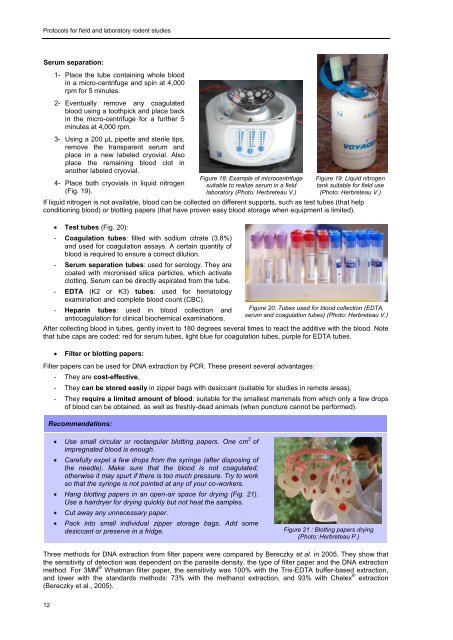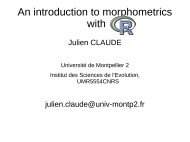Protocols for field and laboratory rodent studies - HAL
Protocols for field and laboratory rodent studies - HAL
Protocols for field and laboratory rodent studies - HAL
Create successful ePaper yourself
Turn your PDF publications into a flip-book with our unique Google optimized e-Paper software.
<strong>Protocols</strong> <strong>for</strong> <strong>field</strong> <strong>and</strong> <strong>laboratory</strong> <strong>rodent</strong> <strong>studies</strong>Serum separation:1- Place the tube containing whole bloodin a micro-centrifuge <strong>and</strong> spin at 4,000rpm <strong>for</strong> 5 minutes.2- Eventually remove any coagulatedblood using a toothpick <strong>and</strong> place backin the micro-centrifuge <strong>for</strong> a further 5minutes at 4,000 rpm.3- Using a 200 µL pipette <strong>and</strong> sterile tips,remove the transparent serum <strong>and</strong>place in a new labeled cryovial. Alsoplace the remaining blood clot inanother labeled cryovial.4- Place both cryovials in liquid nitrogen(Fig. 19).Figure 18: Example of microcentrifugesuitable to realize serum in a <strong>field</strong><strong>laboratory</strong> (Photo: Herbreteau V.)Figure 19: Liquid nitrogentank suitable <strong>for</strong> <strong>field</strong> use(Photo: Herbreteau V.)If liquid nitrogen is not available, blood can be collected on different supports, such as test tubes (that helpconditioning blood) or blotting papers (that have proven easy blood storage when equipment is limited).Test tubes (Fig. 20):- Coagulation tubes: filled with sodium citrate (3.8%)<strong>and</strong> used <strong>for</strong> coagulation assays. A certain quantity ofblood is required to ensure a correct dilution.- Serum separation tubes: used <strong>for</strong> serology. They arecoated with micronised silica particles, which activateclotting. Serum can be directly aspirated from the tube.- EDTA (K2 or K3) tubes: used <strong>for</strong> hematologyexamination <strong>and</strong> complete blood count (CBC).- Heparin tubes: used in blood collection <strong>and</strong>anticoagulation <strong>for</strong> clinical biochemical examinations.Figure 20: Tubes used <strong>for</strong> blood collection (EDTA,serum <strong>and</strong> coagulation tubes) (Photo: Herbreteau V.)After collecting blood in tubes, gently invert to 180 degrees several times to react the additive with the blood. Notethat tube caps are coded: red <strong>for</strong> serum tubes, light blue <strong>for</strong> coagulation tubes, purple <strong>for</strong> EDTA tubes.Filter or blotting papers:Filter papers can be used <strong>for</strong> DNA extraction by PCR. These present several advantages:- They are cost-effective,- They can be stored easily in zipper bags with desiccant (suitable <strong>for</strong> <strong>studies</strong> in remote areas),- They require a limited amount of blood: suitable <strong>for</strong> the smallest mammals from which only a few dropsof blood can be obtained, as well as freshly-dead animals (when puncture cannot be per<strong>for</strong>med).Recommendations:Use small circular or rectangular blotting papers. One cm 2 ofimpregnated blood is enough.Carefully expel a few drops from the syringe (after disposing ofthe needle). Make sure that the blood is not coagulated;otherwise it may spurt if there is too much pressure. Try to workso that the syringe is not pointed at any of your co-workers.Hang blotting papers in an open-air space <strong>for</strong> drying (Fig. 21).Use a hairdryer <strong>for</strong> drying quickly but not heat the samples.Cut away any unnecessary paper.Pack into small individual zipper storage bags. Add somedesiccant or preserve in a fridge.Figure 21 : Blotting papers drying(Photo: Herbreteau P.)Three methods <strong>for</strong> DNA extraction from filter papers were compared by Bereczky et al. in 2005. They show thatthe sensitivity of detection was dependent on the parasite density, the type of filter paper <strong>and</strong> the DNA extractionmethod. For 3MM ® Whatman filter paper, the sensitivity was 100% with the Tris-EDTA buffer-based extraction,<strong>and</strong> lower with the st<strong>and</strong>ards methods: 73% with the methanol extraction, <strong>and</strong> 93% with Chelex ® extraction(Bereczky et al., 2005).12



